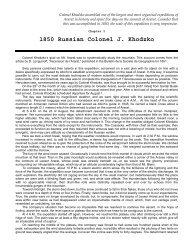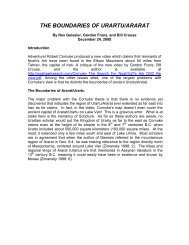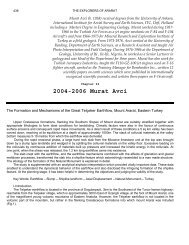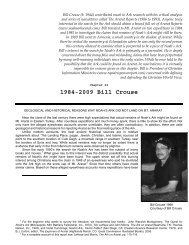The Formation and Mechanics of the Great Telceker Earth Flow
The Formation and Mechanics of the Great Telceker Earth Flow
The Formation and Mechanics of the Great Telceker Earth Flow
Create successful ePaper yourself
Turn your PDF publications into a flip-book with our unique Google optimized e-Paper software.
along <strong>the</strong> following lines: First, a period <strong>of</strong> heavy precipitation <strong>and</strong>/or excessive snow melt followed by<br />
an earthquake tremor (quite common in this region). This combination could have initiated all <strong>the</strong> initial<br />
flows <strong>and</strong> consequently <strong>the</strong> main (Telçeker) flow.<br />
Anyhow, <strong>the</strong> lithology <strong>and</strong> climate in <strong>the</strong> area are synchronous to produce varied examples <strong>of</strong><br />
l<strong>and</strong>slides. For example, an incomplete slumping can be observed in figure 2 PS, developed before<br />
<strong>and</strong> independent <strong>of</strong> Telçeker earthflow. <strong>The</strong> arrows indicate <strong>the</strong> circular trace <strong>of</strong> a slump-type l<strong>and</strong>slide<br />
which occurred in <strong>the</strong> homogeneous part <strong>of</strong> <strong>the</strong> ophiolites. <strong>The</strong> block in view was rotated at its circular<br />
sliding surface for several metres but left no apparent topographic anomaly. Because, it is clear that<br />
<strong>the</strong> sliding cycle <strong>of</strong> <strong>the</strong> slumping process was incomplete, probably because <strong>of</strong> some obstruction in <strong>the</strong><br />
foot area. While it stood at its position as a potential slump, <strong>the</strong> Telçeker earthflow material moved in<br />
<strong>and</strong> covered this foot area ( R ), creating a natural retaining wall which prevented fur<strong>the</strong>r slumping.<br />
IV- How <strong>The</strong> Shiplike Feature Was Formed<br />
Slumps are l<strong>and</strong>slide types which usually take place along a circular plane; <strong>the</strong> slid material is not<br />
transported far but is heaped at <strong>the</strong> root <strong>of</strong> <strong>the</strong> scarp. <strong>The</strong> circular sliding motion is somewhat similar to<br />
<strong>the</strong> motion <strong>of</strong> a human being trying to sit down while his back is against a wall. During this motion, <strong>the</strong><br />
body moves down while <strong>the</strong> legs are bent like a hinge to prevent loss <strong>of</strong> balance. During <strong>the</strong> sliding<br />
process, <strong>the</strong> underlying s<strong>of</strong>t unit (because <strong>of</strong> its homogeneity) is isotropically squeezed down,<br />
(representing <strong>the</strong> legs), it absorbs, <strong>and</strong> slows down <strong>the</strong> pressurising energy <strong>of</strong> <strong>the</strong> upper consolidated<br />
heavy unit (<strong>the</strong> body) which consequently prevents its unbalanced collapse <strong>and</strong> deformation. Similarly<br />
in slumps, if <strong>the</strong> top layer is a consolidated rock layer, it is usually not deformed after <strong>the</strong> slide has<br />
occurred. This is exactly what happened when a huge rock layer first detached <strong>and</strong> slid down from <strong>the</strong><br />
overlying fossiliferous limestone unit at <strong>the</strong> top.<strong>The</strong> shiplike feature is a piece <strong>of</strong> undeformed remnant<br />
<strong>of</strong> <strong>the</strong> hard limestone, brought down by a slump type l<strong>and</strong>slide.<br />
6









